HTC Sensation 4G Review - A Sensational Smartphone
by Brian Klug on July 1, 2011 12:38 AM EST- Posted in
- Smartphones
- HTC
- Android
- Mobile
- HTC Sensation
- MSM8260
Performance
I’ve been skirting around it for no real reason, but the obvious other big important feature on the Sensation is that it’s the first dual core 45nm snapdragon SoC we’ve looked at in a shipping device. The HTC Sensation is built around a 1.2 GHz Qualcomm MSM8260 SoC with Adreno 220 graphics and integrated Previously, we looked at 3D performance on a 1.5 GHz Qualcomm MSM8660 in a Mobile Development Platform, and briefly in our initial hands on preview piece at Uplinq. There, we saw that performance was about where it should be given the difference in resolution between what we had tested (WVGA - 800x480) and the Sensation’s qHD (960x540) display.
The elephant in the room is what CPU performance on MSM8x60 is like. Dual core snapdragon consists of two scorpion cores clocked at up to 1.5 GHz. Anand is going to give a much deeper CPU architecture dive when he looks at the MSM8660 inside the EVO 3D (again, the x in MSM8x60 merely denotes which modem is onboard), but for now I’m going to present all the benchmark results for the Sensation.
First up are our web benchmarks, which primarily test JavaScript and page rendering. We’re still running SunSpider 0.9, though we’ll soon switch to 0.9.1 and report that alongside. JavaScript performance on HTC’s browser isn’t as good as it should be, and I’m a bit disappointed here that things aren’t better. We’ve seen HTC’s browser result in lower scores before, but it still is at odds with what Qualcomm has told me about how closely the two collaborate to optimize V8 for scorpion.
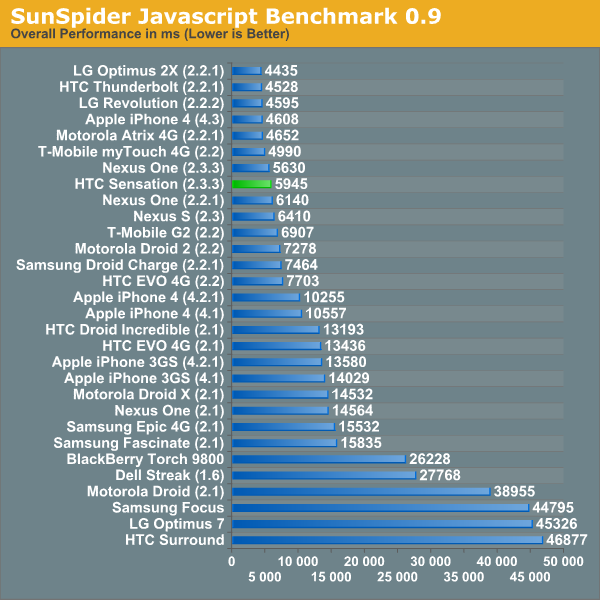
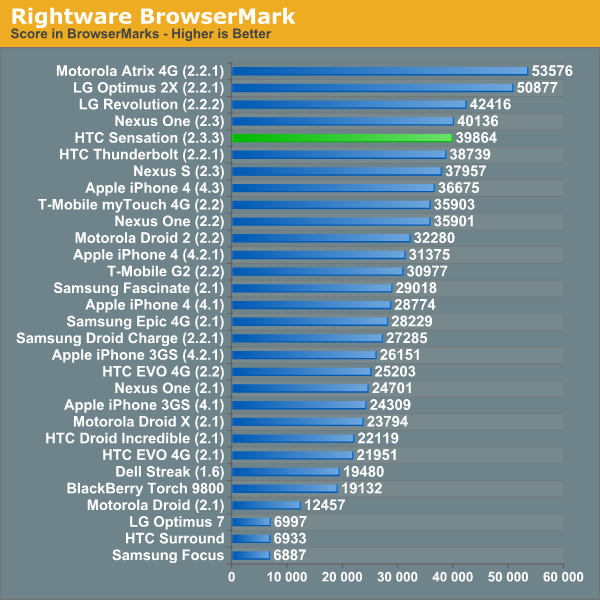
Flash is next, and here the Sensation delivers pretty good performance. It’s hard to make a direct comparison against the Optimus 2X again because we’re dealing with WVGA versus qHD, and we run this test aspect scaled.
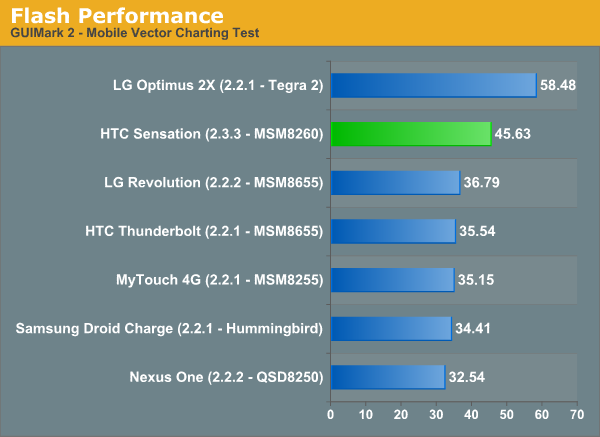
I’m putting Neocore up next because I want to mention again that we’re capped at vsync. We had some hope for a while that we could turn vsync off on handsets, however this is only possible on development hardware, not final ROMs that ship in devices. Odds are you won’t see this pop up again in our suite unless we can make it actually say something. We’re at the Surround’s 60fps wall even at qHD.
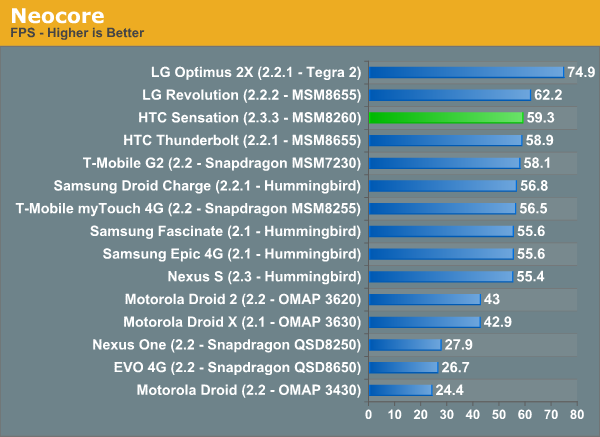
GLBenchmark 2.0 is a mainstay in our benchmarking section, and I’ve already broken down results in our HTC Sensation hands on back at Uplinq. Things have actually improved a bit since that hurried benchmark run over dinner in San Diego, with the Sensation posting around 2fps higher in Egypt and Pro. Again keep in mind the resolution differences between everything here, there’s a 1.35x increase in pixels going from WVGA to qHD.
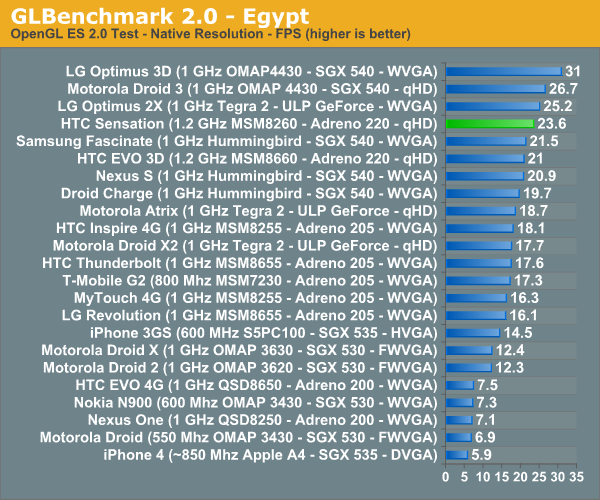
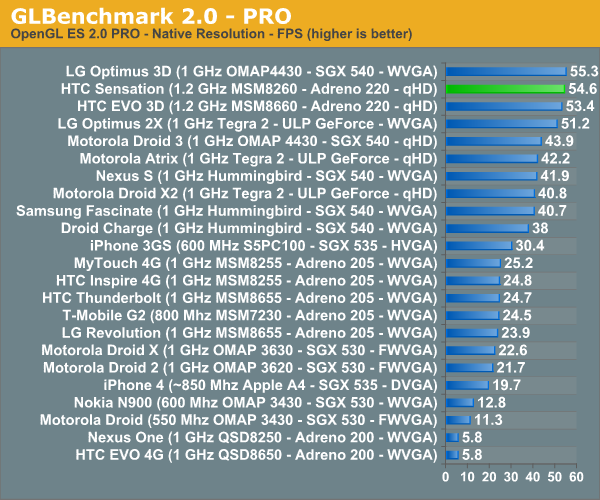
Next is BaseMark ES2.0, which is a nominally updated version of the hugely popular, industry-standard 3DMarkMobile ES2.0. Here we run at the default resolution, which is VGA, and thus get a picture without being constrained to just native resolution constantly. This one is a bit new for us, and I expect that Anand and I are going to explain things a bit more in the EVO 3D story. For now, just take away that MSM8x60 appears very speedy.
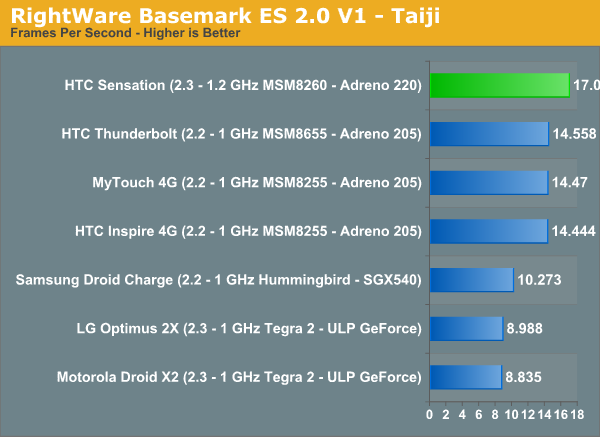
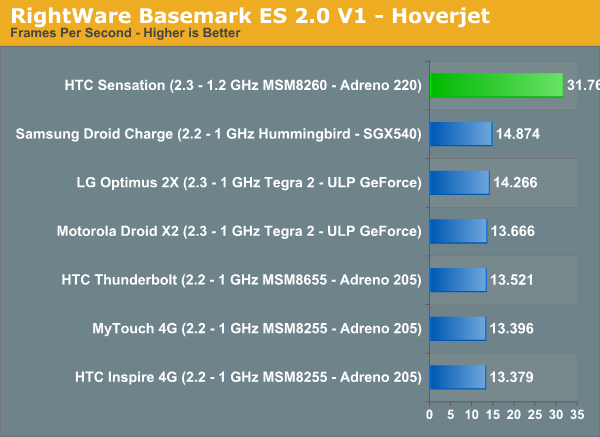
The Android port of Quake 3 is what we sort of started all of this mobile 3D benchmarking with, and we’re still running it even if it’s starting to hit vsync. The results look strange here until you realize that this is again running at native qHD resolution on the Sensation.
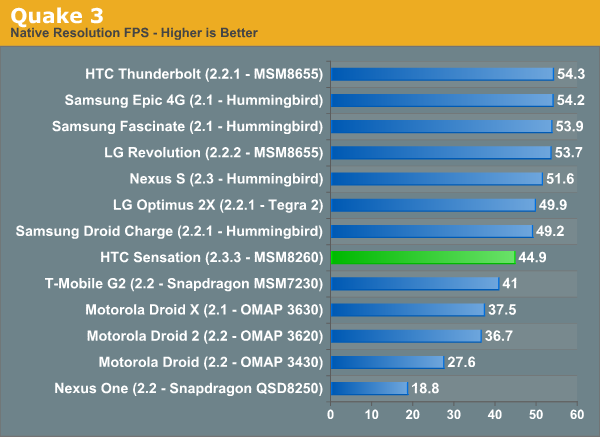
Next up is Linpack, which added a multi-threaded benchmark mode earlier this week. I’ve run it on all the dual core devices I could get my hands on. The initial multi-threaded version had some issues which were fixed on Tuesday, giving more accurate results. We’ll still run the single-threaded version alongside. The 20% jump in clocks shows itself nicely on the Sensation in single-threaded linpack compared to all those 1 GHz MSM8x55 phones we’ve tested.
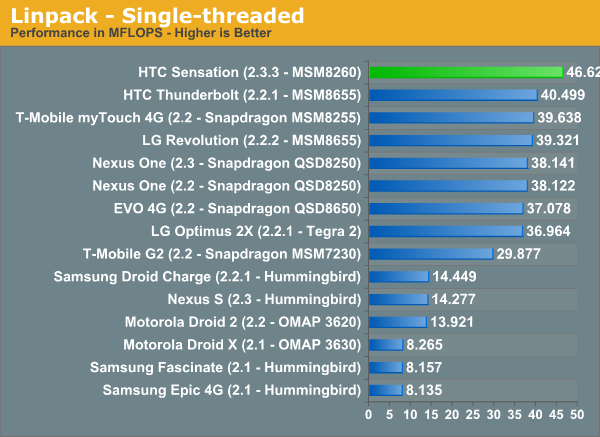
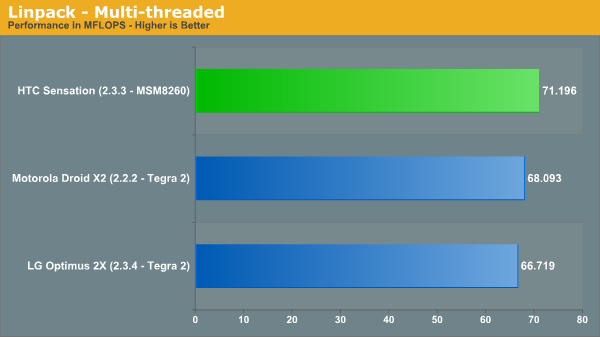
Last and most definitely least is Quadrant, which I think we've gone over our numerous reasons for disliking a few times. The tests themselves are starting to look seriously dated, including 3D tests which render improperly on Android 2.3 and are themselves up against the 60fps vsync cap through their respective runs. I'm sure that the rest of the poorly documented subtests are equally as subpar, however it's become something of a de-facto standard in certain circles.
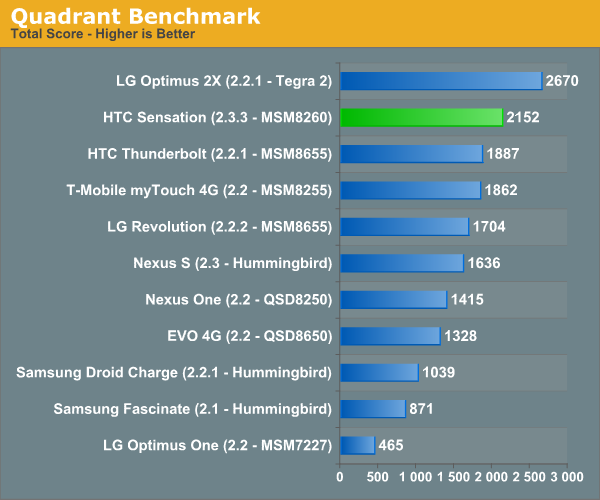
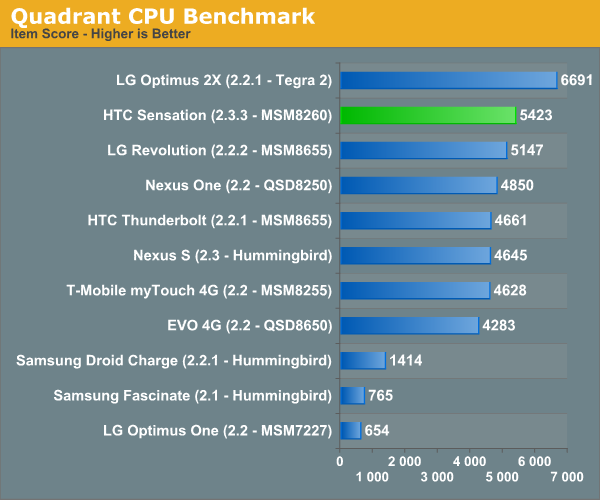
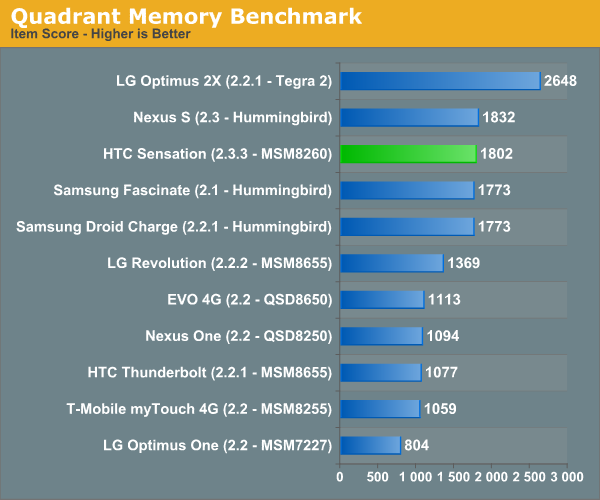
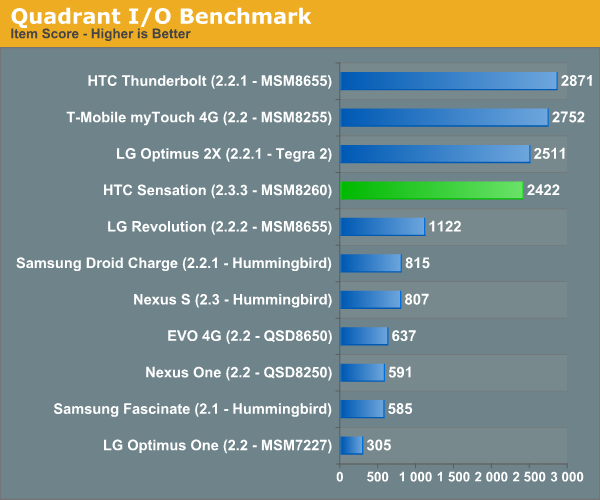
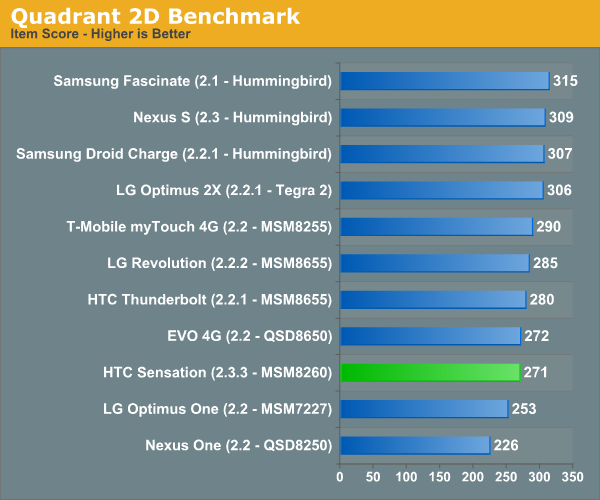
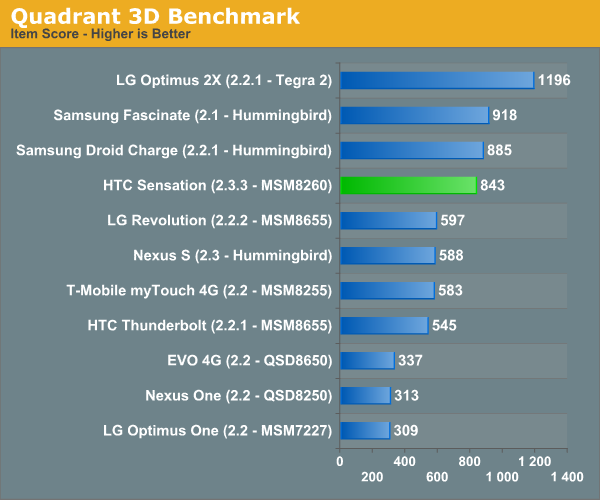
As an aside, I don't think we'll see Quadrant around for much longer, as there are better, more robust, fully documented tools by some established big names coming to the Android market (for free) shortly. All of those will probably quickly and thankfully replace Quadrant, as they all are gunning for its "go-to standard" status as the tool everyone runs, at least from the Android market. I have no doubt they'll quickly succeed.
The state of benchmarking on Android right now is a bit unbalanced, and what everyone wants is a system trace or general use benchmark that will show more than how the CPU does in synthetics and the GPU in synthetics. I fully expect all of that to change this calendar year. Just be patient.










107 Comments
View All Comments
GrizzledYoungMan - Friday, July 1, 2011 - link
And did you nail her or what?Brian Klug - Friday, July 1, 2011 - link
I'm not even sure how to respond, lol. She's my GF ;)-Brian
prophet001 - Friday, July 1, 2011 - link
what a screwed up baseless commentseapeople - Saturday, July 2, 2011 - link
It actually wasn't baseless. His comment was inspired by a picture in the article. You should read more closely.yelped - Friday, July 1, 2011 - link
You left you cellphone number on the Sense 3.0 page, on the notification screenshot under voicemail. :)Brian Klug - Friday, July 1, 2011 - link
That's not actually my number, just this loaner device ;)-Brian
yelped - Friday, July 1, 2011 - link
Good :) When do you think Anand will be ready with his Evo 3d review? Also, do you know if there is a HTC phone with a hardware keyboard based on the Qualcomm 8660 being released soon on Sprint?Thanks!
Brian Klug - Friday, July 1, 2011 - link
Anand will finish up the EVO 3D review next week most likely. He's been under the weather this week, but next is the target.I honestly don't know about an MSM8660 based phone with keyboard coming soon. MSM8260 on T-Mobile with keyboard is coming with the MyTouch 4G Slide though.
-Brian
Pratheek - Friday, July 1, 2011 - link
Since qHD will soon be the default resolution in high end smartphones, I would like to see how qHD S-LCD fares with qHD (SAMOLED+) with RGB stripe layout with slight adjustment in maximum brightness & white point levels...iamkyle - Friday, July 1, 2011 - link
Pics or it didn't happen ;)